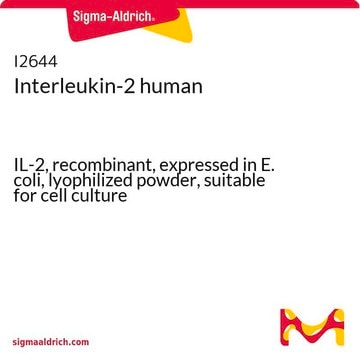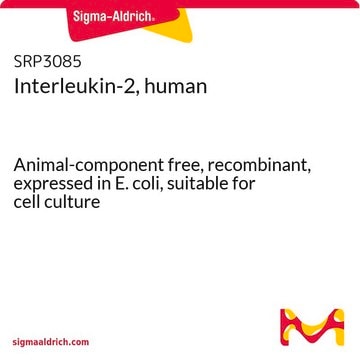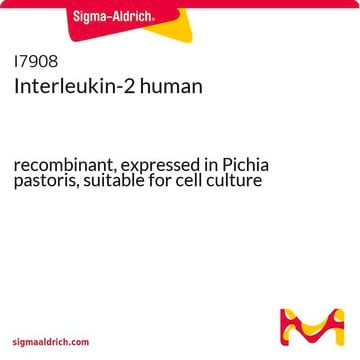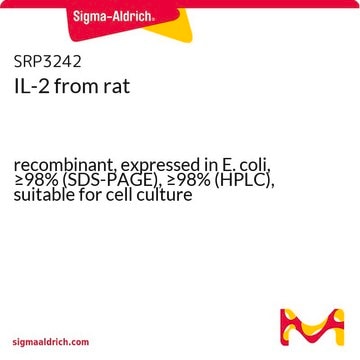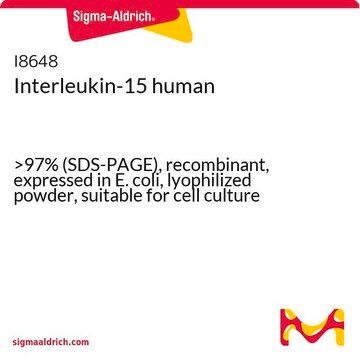HIL2-RO
Roche
Interleukin-2, human (hIL-2)
recombinant (E. coli)
About This Item
Recommended Products
biological source
human
Quality Level
recombinant
expressed in E. coli
Assay
95% (SDS-PAGE)
form
solution
potency
>2 x 10^6 units/mg EC50
mol wt
(15,000 Da)
packaging
pkg of 10,000 U (10799068001 [5 μg, 50 ml])
pkg of 10,000 U (11011456001 [5 μg, 1 ml])
pkg of 50,000 U (11147528001 [25 μg, 5 ml])
manufacturer/tradename
Roche
storage condition
avoid repeated freeze/thaw cycles
concentration
10-20U/ml
impurities
<0.1 EU/μg
UniProt accession no.
storage temp.
−20°C
Gene Information
human ... IL2(3558)
General description
Specificity
Application
- The cultivation of human and murine IL-2 dependent T-cell lines and natural killer cell lines.
- The proliferation of mitogen-activated T-lymphocytes and natural killer cells.
- The establishment of human and murine thymocyte, splenocyte, or peripheral blood lymphocyte (PBL) derived T-cell lines.
- The generation of human and murine lymphokine-activated killer (LAK) cells (1-11).
- In vitro re-stimulation of lung cells obtained from mice.
Biochem/physiol Actions
Quality
Endotoxin level: <0.1 EU/μg (LAL-test), <10 EU/ml (LAL-test)
(1 EU corresponds to 0.1 ng)
Sequence
Unit Definition
Unit Conversion: 1 BM unit = 3.25 NBSB units (natural IL-2)
Physical form
Preparation Note
Established IL-2-dependent T-cell lines usually require 10-20 U/ml. Add IL-2 to the freezing medium for IL-2 dependent cell lines.
Working solution: Dilute the concentrated IL-2 solution (200 U/ml or 10,000 U/ml) with PBS or culture medium containing 1 mg/ml BSA or HSA (0.1%) or 1 to 10% serum.
Storage conditions (working solution): -15 to -25 °C
It is recommended to store the solution in aliquots at -15 to -25 °C.
Note: Avoid repeated freezing and thawing.
Specific activity/EC 50 : >2 x 106 U/mg <0.5 ng/ml (hIL-2, NIBSC, 1st international standard, 86/504), at least the same specific activity (EC50 ) compared to the indicated standard is guaranteed (19, 20). Human, recombinant IL-2 has the same biological activity in vitro as compared to human, natural IL-2 (15, 1–4).
Recommended Method of Dilution: Dilute the concentrated IL-2 solution (200 U/ml or 10,000 U/ml) with PBS or culture medium containing 1 mg/ml BSA or HSA (0.1%) or 1–10% serum.
Interleukin-2 (IL-2, also known as T-Cell Growth Factor, TCGF) is a lymphokine which is produced by lectin- or antigen-activated T-cells and plays an important immunoregulatory role. This factor, or lymphokine, was first identified by its ability to promote the long-term in vitro proliferation of activated T cells. It also promotes the generation and proliferation of cytotoxic T-cells, natural killer (NK) cells, and lymphokine- activated killer (LAK) cells (1–11). Recombinant human IL-2 allows the cultivation of human and murine IL-2-dependent T-cell lines and natural killer cell lines, the proliferation of mitogenactivated T-lymphocytes and natural killer cells, the establishment of human and murine thymocyte-, splenocyte-, or peripheral blood lymphocyte (PBL)- derived T-cell lines, and the generation of human and murine lymphokine-activated killer (LAK) cells (1-11). Established IL-2-dependant T-cell lines usually require 10-20 U/ml. Add IL-2 to the freezing medium for IL-2 dependant cell lines.
Other Notes
also commonly purchased with this product
Storage Class Code
12 - Non Combustible Liquids
WGK
nwg
Flash Point(F)
No data available
Flash Point(C)
No data available
Certificates of Analysis (COA)
Search for Certificates of Analysis (COA) by entering the products Lot/Batch Number. Lot and Batch Numbers can be found on a product’s label following the words ‘Lot’ or ‘Batch’.
Already Own This Product?
Find documentation for the products that you have recently purchased in the Document Library.
Customers Also Viewed
Our team of scientists has experience in all areas of research including Life Science, Material Science, Chemical Synthesis, Chromatography, Analytical and many others.
Contact Technical Service